Our National Parks
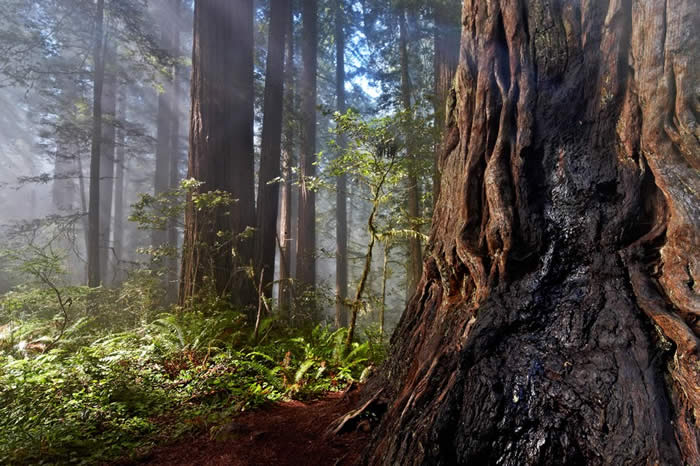
"Our national parks are distinctly unique. Wallace Stegner described them as America's best idea!" Steve Kossack reminds us, "our country has set aside these vast areas of natural beauty and geological wonders for the enjoyment of all the world's citizens. In times of economic downturn, our national parks become public refuges. Most of the workshops I lead are in our national parks. Fine art landscape photography can be done almost anywhere, but it's the emotion and spirit of the parks that I find extra stimulating. It's not only where, but why I photograph!
This summer prompted thoughts of revisiting several of the national parks I've not visited for some time -- parks off the beaten path and the road less traveled. I thought I'd try shooting from a different perspective as well. In a nutshell I would visit three of the quieter parks, two volcanoes, and the tallest trees in the world, with only Canon's four tilt-shift (T/S) lenses in my bag. (In 17mm, 24mm, 45mm and 90mm focal lengths.)
Tilt-shift lenses are designed to control depth of field and perspective. They can dictate what is in or out of focus, as well as what lines of sight are straight or slanted. They can be adjusted to change size and scale. These lenses are manual focus and take time and effort to use. For the most part I become much like a view-camera photographer making many lens movements and constantly refocusing. For me these lenses offer opportunities not present in fixed lenses but like any tool, they can destroy an image just as quickly as make one! For insurance, I added to my kit a Canon 50mm 1.2 lens. In the low light that I usually like and shoot in, I find some instances when I'm not able to see well enough to focus with the T/S lenses and this fast and bright lens gives me the ability at times to set up a shot, at least initially, that I can't make with the other lenses.
My first stop was Redwood National Park, which is located on the northern California coast and has a major highway, CA 101, running through most of it. Redwood is comprised of several state parks along with the national park just outside the little town of Orick. This vast woodland could consume months of a photographer's time but like many of the parks, it can also be enjoyed and photographed in short day trips. The national park has two major areas; The Lady Bird Johnson Grove where the park was founded and The Grove of Big Trees which is accessible by permit only. Campgrounds and lodging are almost everywhere!
The image above was captured with a wideangle T/S-17mm lens that allowed me to get intimate detail up close while still revealing the habitat my focal subject lives in. Here surrounded by hundreds of various species of cluttered trees, I was able to show the majesty and girth of this scarred redwood tree that towered over everything and still hold detail in the forest beyond. Setting up with my 17mm T/S, the rise or shift control gave me the composition I wanted while the camera body maintained the level sensor plane rendering all trees vertical and not falling away as would have been the case with a standard lens pointed upward. This was all that was needed since most of the forest in view was still and I could stop down a bit for depth of field. If you have experience with Canon's new 17mm tilt/shift you'll know that it has a bulbous front lens that makes it impossible to attach filters. However I have been handholding my Singh-Ray graduated ND filters with much success. The trick is to keep the filter level to prevent some parts of the image from blurring. I use my camera's depth-of-field preview to judge where the filter is in my frame. I don't find live view helpful. Of course I needed my larger 4x6-inch versions of the Singh-Ray 3-stop soft-step ND Grad series and had to be careful not to get my fingers in the frame!
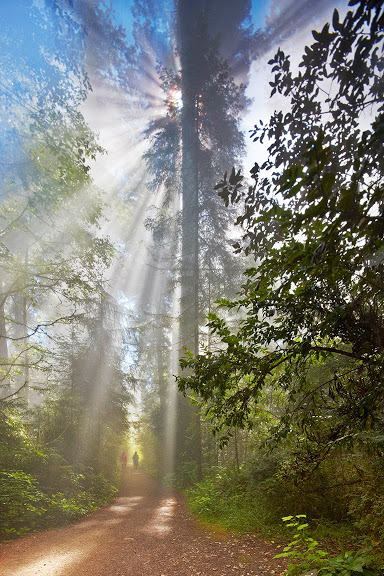 This next image from Redwood National Park was simply breathtaking to make! Again the T/S 17mm was kept level on both planes, horizontally as well as vertically. Then the problem was to place the sun behind the tree with just enough showing to highlight the rays. Next was the use of the Singh-Ray 4-stop soft-step ND Grad and how to place it in the frame. I quickly realized that all would be in vain if the blue clearing at the top left were over exposed. As the sun moved so did I. It was only moments before the effect was gone and I had to set it up a few inches away all over again. The path was the main part of the composition and the grove had very few people in it at this early hour. As a matter of fact most that were there had gathered to watch me working! For perspective, I wanted people on the path and this is the only frame from dozens that answered my request. I was about to ask for volunteers to stage it when these two appeared out of the fog. Can you tell that they are headed in different directions? I waited as long as possible for them to come close to each other. The fact that one is in red was a gift sent along with those photography rays!
This next image from Redwood National Park was simply breathtaking to make! Again the T/S 17mm was kept level on both planes, horizontally as well as vertically. Then the problem was to place the sun behind the tree with just enough showing to highlight the rays. Next was the use of the Singh-Ray 4-stop soft-step ND Grad and how to place it in the frame. I quickly realized that all would be in vain if the blue clearing at the top left were over exposed. As the sun moved so did I. It was only moments before the effect was gone and I had to set it up a few inches away all over again. The path was the main part of the composition and the grove had very few people in it at this early hour. As a matter of fact most that were there had gathered to watch me working! For perspective, I wanted people on the path and this is the only frame from dozens that answered my request. I was about to ask for volunteers to stage it when these two appeared out of the fog. Can you tell that they are headed in different directions? I waited as long as possible for them to come close to each other. The fact that one is in red was a gift sent along with those photography rays!
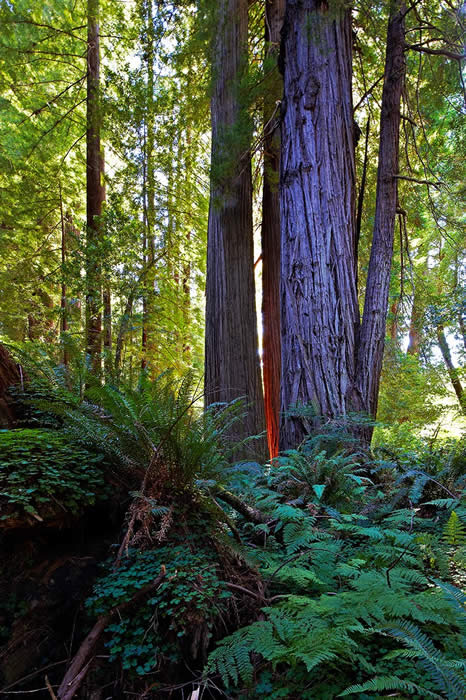 The Grove of Big Trees at Redwood National Park contains some of the tallest trees on the planet and is as much fun to get to and from as capturing this photograph. It is a fairly strenuous hike to the grove. At midafternoon there was almost no direct light anywhere. The solitude and isolation were at once startling, thrilling and overpowering! The tall trees were everywhere but their lower trunks were almost overwhelmed by ferns and maples covered in deep moss. To make a composition from all this was daunting. My solution was again to set the habitat and let the over 200-foot-tall trees be merely the pillars with a foundation of ferns. The only suitable direct light I saw all afternoon led me to it. The tilt feature allowed for the straightening of the trees in the background while the rise set the stage with the ferns. Being down in a gully made both appear to fall away from me. As you can see, that effect was nullified. Singh-Ray 3- and 4-stop ND Grads were combined with the 4-stop stacked slightly higher in the sandwich.
The Grove of Big Trees at Redwood National Park contains some of the tallest trees on the planet and is as much fun to get to and from as capturing this photograph. It is a fairly strenuous hike to the grove. At midafternoon there was almost no direct light anywhere. The solitude and isolation were at once startling, thrilling and overpowering! The tall trees were everywhere but their lower trunks were almost overwhelmed by ferns and maples covered in deep moss. To make a composition from all this was daunting. My solution was again to set the habitat and let the over 200-foot-tall trees be merely the pillars with a foundation of ferns. The only suitable direct light I saw all afternoon led me to it. The tilt feature allowed for the straightening of the trees in the background while the rise set the stage with the ferns. Being down in a gully made both appear to fall away from me. As you can see, that effect was nullified. Singh-Ray 3- and 4-stop ND Grads were combined with the 4-stop stacked slightly higher in the sandwich.
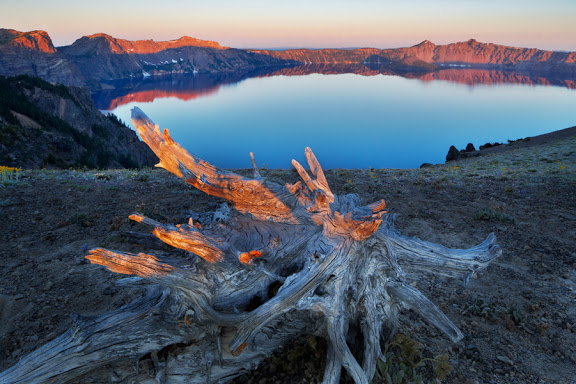
The parks were never assembled in any set or logical way. They are instead simply jewels strung together one at a time to make a beautiful necklace. Not all are equal and not all are the same. Crater Lake was the fourth National Park to be established (1902), and it is unique and unusual. At first glance it boggles the mind! An exploded volcano that left a caldera that was eventually filled by only rain and snowmelt. There are no rivers or streams that flow into the lake which is why it is the purest and deepest in the country, if not the world. The fact that it became a national park so early is what kept it from becoming what Lake Tahoe is today. The lake is 6 miles across and sports two islands. Today the newly rebuilt lodge is still the main feature with the visitor center and usual concession area. The majority of visitors are harbored here with most of the rest in vehicles at overlooks on the loop road. If you are willing to hike even a short distance you will find that the park is quiet and peaceful. I find this place highly inspirational and almost impossible to photograph!
At sunrise in the crisp cold air, the 24mm Canon T/S 24mm provided the desired field of view over Crater Lake from this distance. Struggle as I might with various positions, however, I could not find a vantage point that held the scale. That was solved with the fallen tree. As I scouted the area I found this was one of the few places that you can actually get below the rim safely. Most of the rim is sheer cliff and at first even the loop road seems treacherous to drive, let alone hike. The rise/shift enabled the view above the stump and the tilt allowed me to "lean" the stump toward the lake giving the feeling of pulling it up by its roots!
Lassen National Park in northeastern California is also off the beaten path for most and contains geological features found around the Yellowstone area. A state highway that closes for the winter season is the main access to most of the well-known areas of the park and winds its way around three quarters of the volcano. Although dormant now, Lassen Peak exploded twice in a matter of a few days almost one hundred years ago. It takes a little hiking to witness the thermal features.
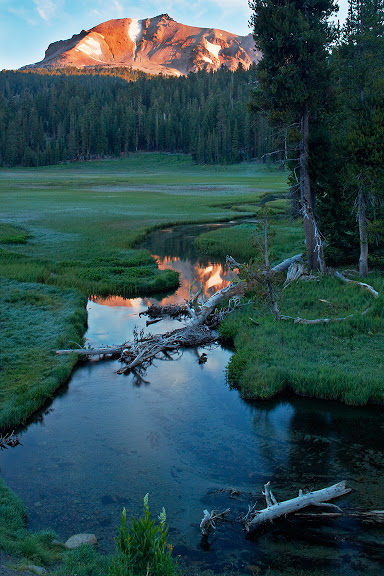 Finding a setting with as many of the parks features as Kings Meadow offers was a gift, and I did this particular set-up three times! I was reminded of Tuolumne Meadows in the high country of Yosemite and how short the time of green meadow grasses are there as I pondered a composition. On this almost cloudless morning in the meadow before the volcano and in the dark I used my Canon 50mm f1.2 for visibility and made several thirty second frames wide open to tweak the composition. As suspected, pointing downhill rendered the trees on the right and the volcano leaning severely and smaller in scale. As soon as I had enough light to focus manually I switched over to the 45 T/S and mounted a Singh-Ray ColorCombo being careful to keep the reflection and still be able to see into the river. At times the wind picked up and the plants in the foreground began to sway.
Finding a setting with as many of the parks features as Kings Meadow offers was a gift, and I did this particular set-up three times! I was reminded of Tuolumne Meadows in the high country of Yosemite and how short the time of green meadow grasses are there as I pondered a composition. On this almost cloudless morning in the meadow before the volcano and in the dark I used my Canon 50mm f1.2 for visibility and made several thirty second frames wide open to tweak the composition. As suspected, pointing downhill rendered the trees on the right and the volcano leaning severely and smaller in scale. As soon as I had enough light to focus manually I switched over to the 45 T/S and mounted a Singh-Ray ColorCombo being careful to keep the reflection and still be able to see into the river. At times the wind picked up and the plants in the foreground began to sway.
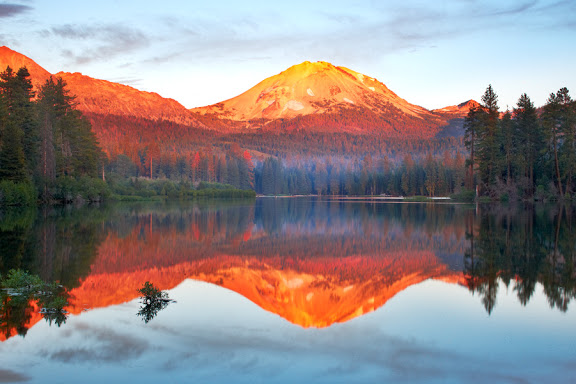
This final image was captured at Manzanita Lake, which is located in Lassen Volcanic National Park. One of the inescapable feelings as I visit any of the volcanoes in the Pacific 'Rim of Fire' is the fact that they can become active again at any time. Sure there exists modern equipment to measure movement and loads of people interested in monitoring every aspect every minute, but as I watched a thunderstorm develop to the west and then some of it dissipate over Manzanita Lake with wafts of smoke from campfires, I could not help feeling that I was waiting in tranquility for the next 'blast' and that it might occur before dark! Here the T/S 24mm was used without tilt or shift. I've I learned that in photography and especially in life itself, just because you can make adjustments does not necessarily mean you should! However, I did use my Singh-Ray ColorCombo and a 4-stop soft-step ND Grad to lend the finishing touches to the light."
Client Comments
"I been spending some time lately thinking about what what really brings joy into my life. Outdoor photography and all that it encompasses is a very very large part of that In my quiet moments I go to those special places in my mind and remember the feelings I was trying to capture with my camera. I appreciate you introducing me to that world. Our first trip was to Yosemite in the winter. I appreciated you and Tim being so patent with me as I knew very little about photography. It has grown from there. I appreciate the fundamentals you have taught me. It is the best way to do things. The thing I most appreciate is your passion for nature and struggle for survival and beautiful things and beautiful places. For me it was contagious and has added a whole new dimension to my life. You gave me a gift that was unique to you. Steve, I want to thank you for that."
